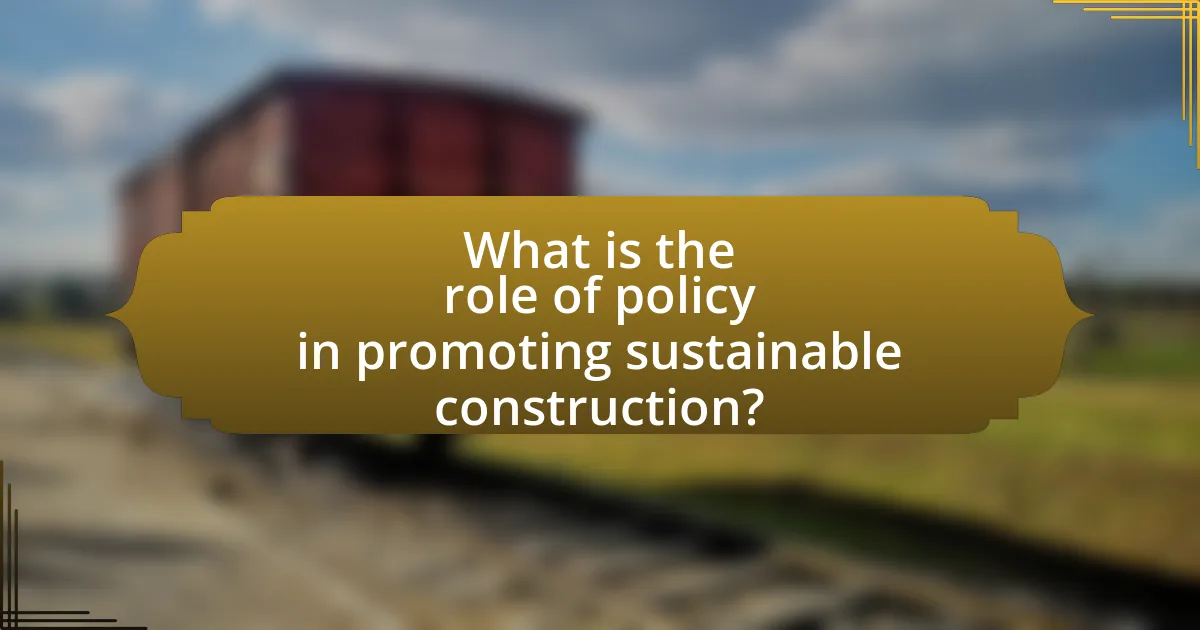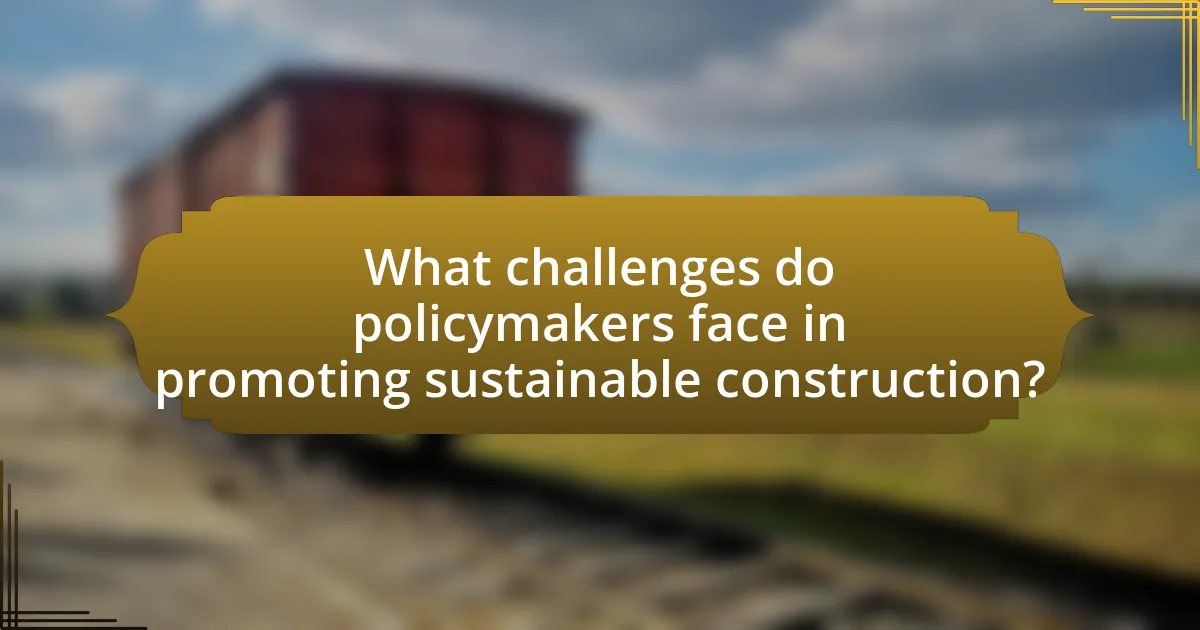The article focuses on the critical role of policy in promoting sustainable construction practices. It outlines how regulations, economic incentives, and educational initiatives shape the construction industry towards environmentally responsible methods. Key topics include the effectiveness of various policies, the impact of regulations on construction methods and materials, and the long-term benefits of sustainable construction policies. Additionally, the article addresses challenges faced by policymakers, the influence of economic factors, and the importance of community engagement in ensuring successful policy implementation. It emphasizes the need for collaboration among stakeholders and the integration of innovative technologies to enhance compliance with sustainability standards.

What is the role of policy in promoting sustainable construction?
Policy plays a crucial role in promoting sustainable construction by establishing regulations and incentives that encourage environmentally responsible building practices. Governments implement policies such as building codes, zoning laws, and financial incentives to reduce carbon emissions, enhance energy efficiency, and promote the use of sustainable materials. For instance, the adoption of the International Green Construction Code (IgCC) provides a framework for sustainable building practices, ensuring that new constructions meet specific environmental standards. Additionally, policies that offer tax credits or grants for green building projects further incentivize developers to adopt sustainable practices, leading to a measurable reduction in the environmental impact of the construction industry.
How do policies influence sustainable construction practices?
Policies significantly influence sustainable construction practices by establishing regulatory frameworks that promote environmentally responsible building methods. For instance, building codes and zoning laws can mandate energy efficiency standards, thereby encouraging the use of sustainable materials and technologies. Research by the World Green Building Council indicates that countries with stringent environmental regulations see a higher adoption rate of green building practices, demonstrating a direct correlation between policy enforcement and sustainable outcomes. Additionally, financial incentives such as tax credits for green construction projects further motivate developers to integrate sustainability into their practices, reinforcing the role of policy in shaping industry standards.
What types of policies are most effective in promoting sustainability?
Regulatory policies, economic incentives, and educational initiatives are the most effective in promoting sustainability. Regulatory policies, such as building codes and environmental regulations, set mandatory standards that ensure sustainable practices in construction. Economic incentives, including tax credits and subsidies for green building materials, encourage developers to adopt sustainable technologies. Educational initiatives raise awareness and provide training on sustainable practices, fostering a culture of sustainability within the construction industry. For instance, the implementation of the Energy Policy Act of 2005 in the United States has led to increased energy efficiency in buildings, demonstrating the effectiveness of regulatory measures in promoting sustainability.
How do regulations impact construction methods and materials?
Regulations significantly influence construction methods and materials by establishing standards that ensure safety, sustainability, and environmental protection. For instance, building codes dictate structural integrity, fire safety, and energy efficiency, compelling builders to adopt specific materials and techniques that comply with these requirements. Additionally, environmental regulations, such as the Clean Air Act and the Clean Water Act, restrict the use of harmful substances and promote the use of eco-friendly materials, thereby shaping construction practices towards sustainability. These regulations not only enhance public safety but also drive innovation in the industry, as companies seek compliant yet efficient construction solutions.
Why is policy important for sustainable development in construction?
Policy is crucial for sustainable development in construction because it establishes regulatory frameworks that guide practices towards environmental, social, and economic sustainability. Effective policies promote the use of sustainable materials, energy efficiency, and waste reduction, ensuring that construction activities minimize their ecological footprint. For instance, the implementation of building codes and standards, such as LEED (Leadership in Energy and Environmental Design), has been shown to significantly reduce energy consumption and greenhouse gas emissions in buildings. Furthermore, policies can incentivize innovation in sustainable technologies, leading to long-term benefits for both the industry and society.
What are the long-term benefits of sustainable construction policies?
Sustainable construction policies provide long-term benefits such as reduced environmental impact, enhanced energy efficiency, and improved public health. These policies promote the use of eco-friendly materials and practices, which lead to lower carbon emissions and resource conservation. For instance, buildings designed under sustainable guidelines can reduce energy consumption by up to 30%, as reported by the U.S. Green Building Council. Additionally, sustainable construction can lead to cost savings over time, with energy-efficient buildings often resulting in lower utility bills and maintenance costs. Furthermore, these policies contribute to healthier living environments, as they often incorporate better air quality and natural lighting, which can enhance occupant well-being.
How do policies address environmental concerns in construction?
Policies address environmental concerns in construction by establishing regulations and standards that promote sustainable practices. These policies often include requirements for energy efficiency, waste reduction, and the use of environmentally friendly materials. For instance, the International Energy Conservation Code mandates energy-efficient building designs, which significantly reduce greenhouse gas emissions. Additionally, policies may incentivize the adoption of green building certifications, such as LEED, which encourage developers to implement sustainable practices. These measures collectively aim to minimize the environmental impact of construction activities and promote long-term sustainability in the industry.

What challenges do policymakers face in promoting sustainable construction?
Policymakers face significant challenges in promoting sustainable construction, primarily due to economic constraints, regulatory complexities, and stakeholder resistance. Economic constraints arise from the higher initial costs associated with sustainable materials and technologies, which can deter investment despite long-term savings. Regulatory complexities include navigating existing building codes and zoning laws that may not support innovative sustainable practices. Additionally, stakeholder resistance often stems from a lack of awareness or understanding of the benefits of sustainable construction, making it difficult to gain support from developers, contractors, and the public. These challenges hinder the effective implementation of policies aimed at fostering sustainable building practices.
How do economic factors affect policy implementation?
Economic factors significantly influence policy implementation by determining the availability of resources, funding, and overall economic stability necessary for executing policies. For instance, during economic downturns, governments may prioritize budget cuts, which can lead to reduced funding for sustainable construction initiatives. A study by the World Bank indicates that countries with higher GDP growth rates tend to invest more in sustainable infrastructure, demonstrating a direct correlation between economic health and the capacity to implement effective policies. Additionally, economic incentives, such as tax breaks or subsidies for green building practices, can motivate stakeholders to comply with sustainability policies, thereby enhancing their effectiveness.
What role does funding play in sustainable construction initiatives?
Funding is crucial for sustainable construction initiatives as it provides the necessary financial resources to implement eco-friendly practices and technologies. Adequate funding enables the adoption of sustainable materials, energy-efficient systems, and innovative construction methods that reduce environmental impact. For instance, a study by the World Green Building Council indicates that green buildings can lead to a 30% reduction in energy consumption, which is often made possible through initial investments supported by funding. Furthermore, government incentives and grants can significantly lower the financial barriers for developers, encouraging more projects to pursue sustainability goals.
How can policymakers overcome resistance from the construction industry?
Policymakers can overcome resistance from the construction industry by implementing targeted incentives and fostering collaboration. By offering financial incentives such as tax breaks or grants for sustainable practices, policymakers can motivate construction firms to adopt environmentally friendly methods. For instance, a study by the World Green Building Council found that financial incentives significantly increased the adoption of green building practices among construction companies. Additionally, creating platforms for dialogue between policymakers and industry stakeholders can address concerns and facilitate the sharing of best practices, leading to a more cooperative approach to sustainable construction.
What social factors influence the effectiveness of construction policies?
Social factors that influence the effectiveness of construction policies include community engagement, public perception, and socio-economic conditions. Community engagement ensures that local stakeholders are involved in the decision-making process, which can lead to policies that better reflect the needs and values of the population. Public perception affects the acceptance and support of construction initiatives; for instance, if the community views a project as beneficial, it is more likely to succeed. Socio-economic conditions, such as income levels and education, also play a critical role, as they determine the capacity of communities to participate in and benefit from construction policies. Studies have shown that areas with higher levels of community involvement and positive public perception tend to have more successful construction outcomes, reinforcing the importance of these social factors in policy effectiveness.
How do community attitudes impact policy success?
Community attitudes significantly impact policy success by influencing public support and engagement with initiatives. When communities are favorable towards sustainable construction policies, they are more likely to participate in and adhere to these initiatives, leading to higher implementation rates. For instance, a study by the National Institute of Building Sciences found that community buy-in can increase the effectiveness of sustainable building practices by up to 30%. Conversely, negative attitudes can result in resistance, protests, or non-compliance, undermining policy objectives. Therefore, understanding and addressing community perspectives is crucial for the successful enactment and sustainability of construction policies.
What strategies can enhance public support for sustainable construction policies?
Engaging the public through education and awareness campaigns can significantly enhance support for sustainable construction policies. These campaigns can inform citizens about the environmental, economic, and social benefits of sustainable practices, such as reduced energy consumption and improved public health. Research indicates that communities with strong educational initiatives, like the “Green Building Program” in San Francisco, have seen increased public backing for sustainable policies, demonstrating that informed citizens are more likely to advocate for and support such initiatives.

What are the best practices for developing effective policies in sustainable construction?
The best practices for developing effective policies in sustainable construction include stakeholder engagement, evidence-based decision-making, and clear regulatory frameworks. Stakeholder engagement ensures that the perspectives of all parties, including builders, environmentalists, and community members, are considered, leading to more comprehensive policies. Evidence-based decision-making relies on data and research to inform policy choices, which enhances the effectiveness and credibility of the policies. Clear regulatory frameworks provide specific guidelines and standards that facilitate compliance and promote sustainable practices. For instance, the International Energy Agency reports that countries with well-defined energy efficiency policies see a 20% increase in sustainable construction practices.
How can collaboration improve policy outcomes in construction?
Collaboration can significantly improve policy outcomes in construction by fostering stakeholder engagement and ensuring diverse perspectives are considered. When various stakeholders, including government agencies, contractors, and community members, work together, they can identify common goals and address potential conflicts early in the policy development process. Research indicates that collaborative approaches lead to more effective and sustainable policies, as evidenced by the success of integrated project delivery methods, which have been shown to reduce costs and enhance project efficiency by up to 20%. This collaborative framework not only enhances transparency but also builds trust among stakeholders, ultimately leading to policies that are more widely accepted and successfully implemented in the construction sector.
What stakeholders should be involved in the policy-making process?
The stakeholders involved in the policy-making process for promoting sustainable construction include government agencies, industry professionals, non-governmental organizations (NGOs), community representatives, and academic institutions. Government agencies are essential as they create and enforce regulations that guide sustainable practices. Industry professionals, such as architects and builders, provide practical insights and expertise on sustainable construction methods. NGOs advocate for environmental and social considerations, ensuring that policies reflect community needs. Community representatives offer local perspectives and priorities, while academic institutions contribute research and innovation to inform policy decisions. Together, these stakeholders ensure a comprehensive approach to sustainable construction policy.
How can data and research inform policy decisions?
Data and research can inform policy decisions by providing evidence-based insights that guide the formulation and implementation of effective policies. For instance, studies such as the “Global Status Report 2020” by the United Nations Environment Programme highlight the impact of construction practices on sustainability, demonstrating that data on carbon emissions and resource usage can lead to regulations that promote eco-friendly building methods. Additionally, research findings can identify best practices and innovative technologies, enabling policymakers to create frameworks that incentivize sustainable construction practices, ultimately leading to reduced environmental impact and improved resource efficiency.
What role does technology play in supporting sustainable construction policies?
Technology plays a crucial role in supporting sustainable construction policies by enabling efficient resource management and reducing environmental impact. Advanced technologies such as Building Information Modeling (BIM) facilitate precise planning and resource allocation, which minimizes waste and optimizes energy use during construction. Additionally, renewable energy technologies, like solar panels and energy-efficient systems, are integrated into building designs, aligning with sustainability goals. According to a report by the World Green Building Council, buildings that utilize smart technologies can reduce energy consumption by up to 30%, demonstrating the effectiveness of technology in promoting sustainable practices within the construction industry.
How can innovative technologies enhance compliance with sustainability standards?
Innovative technologies enhance compliance with sustainability standards by providing tools for better monitoring, reporting, and management of environmental impacts. For instance, IoT sensors enable real-time tracking of energy consumption and waste generation, allowing organizations to adjust practices promptly to meet sustainability benchmarks. Additionally, blockchain technology ensures transparency in supply chains, making it easier to verify compliance with sustainability standards. A study by the World Economic Forum highlights that companies using advanced technologies can reduce their carbon footprint by up to 30% through improved efficiency and accountability.
What examples exist of successful technology integration in construction policies?
Successful technology integration in construction policies can be seen in the implementation of Building Information Modeling (BIM) across various jurisdictions. For instance, the UK government mandated the use of BIM Level 2 for all public sector projects by 2016, which resulted in improved collaboration, reduced costs, and enhanced project delivery efficiency. Additionally, Singapore’s Building and Construction Authority has adopted a Smart Nation initiative, promoting the use of digital technologies such as drones and IoT for construction monitoring and management, leading to increased productivity and safety on construction sites. These examples demonstrate how specific policies can effectively drive the adoption of advanced technologies in the construction sector.
What practical steps can be taken to implement sustainable construction policies effectively?
To implement sustainable construction policies effectively, governments and organizations should establish clear regulations, provide financial incentives, and promote education and training in sustainable practices. Clear regulations, such as building codes that mandate energy efficiency and sustainable materials, ensure compliance and set standards for construction projects. Financial incentives, including tax credits and grants for green building initiatives, encourage developers to adopt sustainable practices. Furthermore, education and training programs for construction professionals enhance knowledge and skills related to sustainability, fostering a culture of environmentally responsible building. These steps are supported by studies indicating that regulatory frameworks and financial support significantly increase the adoption of sustainable construction practices, leading to reduced environmental impact and improved resource efficiency.

Leave a Reply